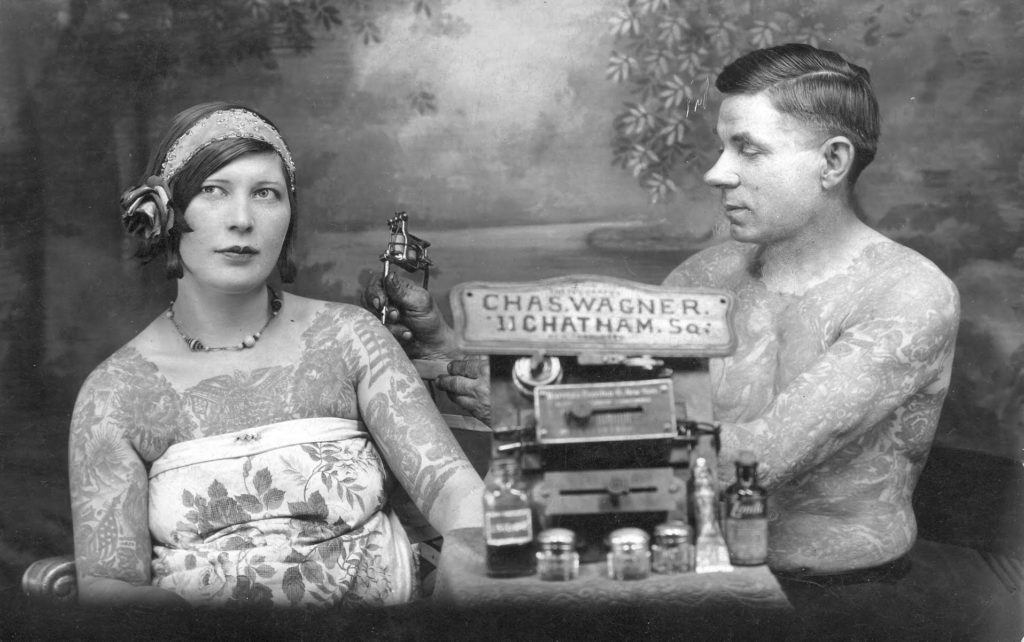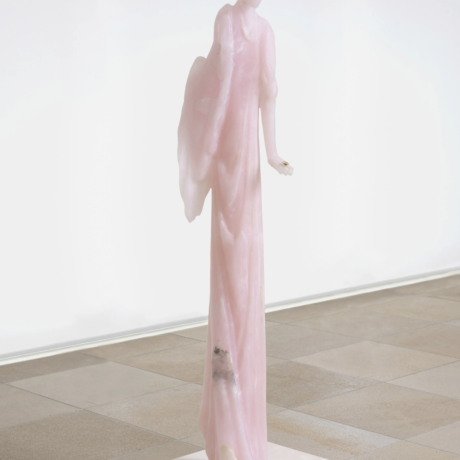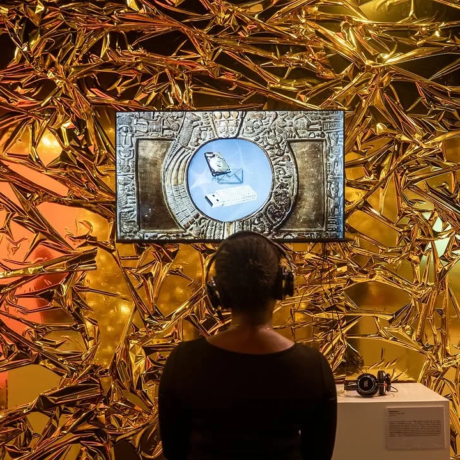
As the 2020s dawned, the Y2K Renaissance began. Ushered in by a desire for a sparklier, more hedonistic time, this wave of nostalgia brought back all the trademarks of feminine late 1990s and early 2000s style: low-rise jeans, tiny handbags, baby tees, butterfly clips, acrylic nails, and embellished belts chunkier than the mini skirts they hold in place. Through rhinestones, velour and distressed denim, fashion became supercharged with a clashy, trashy glamour that feels fun, flirty and free.
But amidst all the rose-tinted romanticisation of Y2K culture, it is all too easy to gloss over the time’s rampant misogyny, as pervasive as the flip phone. Body-judging, slut-shaming and impossible double standards were rife, all perpetuated by the tabloid press. And one Y2K aesthetic suffered more than any other: the lower-back tattoo aka the so-called ‘tramp stamp’.
From Britney’s fairy to Brandy Norwood’s flower, Christina Aguilera’s romantic quote to Drew Barrymore’s angels, Nicole Richie’s cross to Jessica Alba’s bow, these cute bits of body art peeked out from backless dresses and Juicy Couture sweatpants, earning their place in the noughties hall of fame. But, as their derogative nickname confirms, even in their heyday they were the target of sexist ridicule. Much like the celebrities who wore them, tramp stamps were excessively sexualised by the media and then their owners were shamed because of them.

The tramp stamp wasn’t always the tramp stamp, though. As Margot Mifflin writes in Bodies of Subversion (2013), “women artists brought a new sensitivity to tattoo placement” during the late 1980s and 1990s. Among them was Los Angeles artist Jill Jordan, a former fashion designer, who called the lower back tattoo “the chick spot” and described it as “a tremendously sexy and really flattering way to be tattooed: it just narrows your waist.” By the turn of the millennium, Mifflin continues, “this had become such a clichéd location for women’s tattoos, displayed popping out of low-slung hip-huggers, that it was known as the ‘tramp stamp’.
“It’s just a very beautiful part of the body. The lower back is this big, stretched, flat surface, which gives you a lot of freedom to work with”
What came first, the tramp stamp or the low-rise jeans? It would appear the lower back tat did, but it only began to trend as waistbands got lower, along with belly button piercings and ‘whale tail’ thongs. However, the tattoo’s cultural downgrade came less from its ubiquity and more from misogynistic associations with promiscuity. “Tattoo on the lower back, might as well be a bullseye,” quips Vince Vaughn’s character in Wedding Crashers (2005), evincing the belief that a woman taking ownership of a sensuous part of her body through the art of tattooing is an instant invitation for sex.
In 2009, to celebrate her 50th birthday, Barbie was given a tramp stamp as part of Mattel’s “Totally Tattoos” range. Never one to miss an opportunity for body-shaming, even in the case of a plastic toy, The Daily Mail ran a feature on it, expressing their horror at this disruptive addition to Barbie’s “blonde locks, slender legs and sweet smile” and their fear that it could “further encourage the sexualisation of young girls”. One reader weighed in: “Barbie should be at the high end of fashion, not the chav end. Whatever will they bring out next? Drug-addict Barbie? Alcoholic Barbie?”
While these sentiments encapsulate the lower back tat’s taboo status by the end of the 2000s, tattoo historian Matt Lodder says this kind of coverage is nothing new. He points to a tabloid article from 1950 about young women getting spider tattoos on their backs as good luck charms: “What will women think of next?” reads the outraged opening line. “Women getting tattooed has been a fascination of the tabloid media for a long time,” Lodder explains. “Especially in the late 1800s and early 1900s, it was an excuse to put pictures of women wearing fewer clothes in the newspaper than you’d normally be able to.”
Much like the paparazzi’s pseudo-moral mission to document every nip slip of the noughties, tattoo shaming satisfied a voyeuristic desire for skin. The stigma stuck, though. In the 2010s, tramp stamps became code for young and reckless decision-making. Richie got hers removed in 2013, saying: “It just means a certain thing, and I don’t want to be part of that group.” And in 2015, Alba laughed along as James Corden and Ben Schwartz mocked her bow.
“Tramp stamps were excessively sexualised by the media and then their owners were shamed because of them”
But the tide is turning. Berlin-based Chilean tattoo artist Maca (@miedoalvacio) says she’s getting more and more requests for lower-back tattoos. Like Jill Jordan, she emphasises the sensuousness of the placement. “It’s just a very beautiful part of the body,” she says. “On a technical level, the lower back is this big, stretched, flat surface, which gives you a lot of freedom to work with.”
“Women getting tattooed has been a fascination of the tabloid media for a long time”
While alternative names have been suggested (Drew Barrymore and Dakota Johnson recently threw “butt crown”, into the mix, akin to the German Arschgeweih or “ass antlers”), Maca likes “tramp stamp”. “Obviously the expression was meant to be disrespectful, but I believe in reclaiming these words, in making them our own,” she says. “I really love that it’s coming back and I hope it’s here to stay. I hope that the lower back will be accepted as just another tattoo spot, like the underboob or the forearm.”
Adam Takar, a 24-year-old training tattoo artist in Berlin, is conjuring up an “abstract, cyborg-looking design” for their tramp stamp. They see the tattoo’s resurgence as part of a broader celebration of “bimbo” culture among queer people. “It’s this part-parody, part-transformation of these derided fashion trends and gender expressions,” Takar says. “Because I’m exploring my gender identity, the bimbo aesthetic allows me to feminise my masculinity. I like wearing a mini skirt and having ‘slutty’ tattoos: it’s empowering to embrace all the femininity that was battered out of me at school.”
Adam’s early memories of tramp stamps are from the 2000s music videos they’d dance along to then. “I now associate the tramp stamp with making myself feel more sexually liberated in a clubbing scene, where I dance how I used to dance as a kid,” they say. “It’s like a revival of that childhood carefree-ness. It feels like a reclamation of the parts of my body that I wasn’t allowed to show or wasn’t allowed to move in that way.”
View this post on Instagram
Eloise Chan, a nail artist based in north Wales, recently got her own tramp stamp, a tribal pattern with a love heart at the centre. “I wanted one for ages, but I put it off because of how they’re viewed,” says the 18-year-old. “Then this year I just thought, screw it, I want it, I’m going to get it. It makes me feel powerful. It’s like a mini movement of anarchy.”
More than any other Y2K trend, the return of the tramp stamp both acknowledges and rebels against the sexist legacy of the era. Whether you’re embracing it for the beauty of its placement, or for its liberating potential, it’s time this tattoo made its mark.
Madeleine Pollard is a Berlin-based journalist specialising in culture and current affairs
Learn how to design your own tattoo artwork in our Elephant Academy online workshop!





